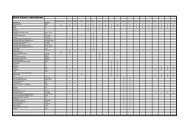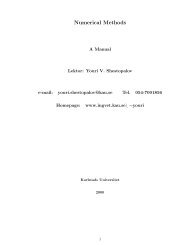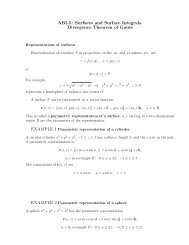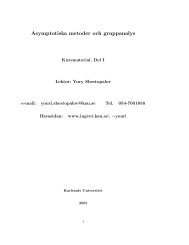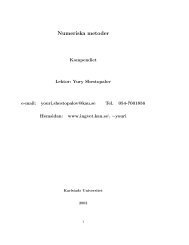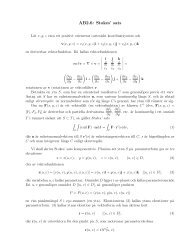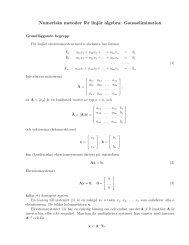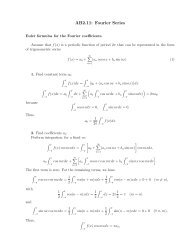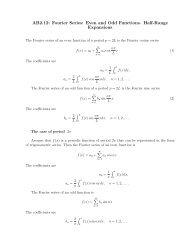5.3 Linear Volterra IE of the 2nd kindConsider a Volterra IE of the 2nd kindf(x) = φ(x) + λ∫ xaK(x, y)φ(y)dy, (68)where the kernel K(x, y) is a continuous function in the square Π for some b > a, so that|K(x, y)| ≤ M for (x, y) ∈ Π.Formulate a generalization of the principle of contraction mappings.Theorem 4 If A is a continuous mapping of a complete metric space R into itself such thatthe mapping A n is a contraction for some n, then the equation Ax = x has one and only onesolution.In fact if we take an arbitrary point x ∈ R and consider the sequence A kn x, k = 0, 1, 2, . . ., therepetition of the proof of the classical principle of contraction mappings yields the convergenceof this sequence. Let x 0 = lim k→∞ A kn x, then Ax 0 = x 0 . In fact Ax 0 = lim k→∞ A kn Ax. Sincethe mapping A n is a contraction, we haveρ(A kn Ax, A kn x) ≤ αρ(A (k−1)n Ax, A (k−1)n x) ≤ . . . ≤ α k ρ(Ax, x).Consequently,limk→∞ ρ(Akn Ax, A kn x) = 0,i.e., Ax 0 = x 0 .Consider the mapping g = Af defined byg(x) = φ(x) + λof the complete space C[a, b] into itself.5.4 Neumann series∫ xaK(x, y)φ(y)dy, (69)Consider an IE∫ bf(x) = φ(x) − λ K(x, y)φ(y)dy, (70)aIn order to determine the solution by the method of successive approximations and obtain theNeumann series, rewrite (70) as∫ bφ(x) = f(x) + λ K(x, y)φ(y)dy, (71)aand take the right-hand side f(x) as the zero approximation, settingφ 0 (x) = f(x). (72)Substitute the zero approximation into the right-hand side of (73) to obtain the first approximation∫ bφ 1 (x) = f(x) + λ K(x, y)φ 0 (y)dy, (73)a14
and so on, obtaining for the (n + 1)st approximation∫ bφ n+1 (x) = f(x) + λ K(x, y)φ n (y)dy. (74)aAssume that the kernel K(x, y) is a bounded function in the square Π = {(x, y) : a ≤ x ≤b, a ≤ y ≤ b}, so that|K(x, y)| ≤ M, (x, y) ∈ Π.or even that there exists a constant C 1 such that∫ bThe the following statement is valid.a|K(x, y)| 2 dy ≤ C 1 ∀x ∈ [a, b], (75)Theorem 5 Assume that condition (75) holds Then the sequence φ n of successive approximations(74) converges uniformly for all λ satisfyingλ ≤ 1 B ,B = ∫ bThe limit of the sequence φ n is the unique solution to IE (70).a∫ ba|K(x, y)| 2 dxdy. (76)Proof. Write two first successive approximations (74):Set∫ bf(x) + λa∫ bφ 1 (x) = f(x) + λ K(x, y)f(y)dy, (77)a∫ bφ 2 (x) = f(x) + λK(x, y)f(y)dy + λ 2 ∫ bK 2 (x, y) =∫ bto obtain (by changing the order of integration)∫ bφ 2 (x) = f(x) + λaIn the same manner, we obtain the third approximationaaK(x, y)φ 1 (y)dy = (78)a∫ bK(x, t)dt K(t, y)f(y)dy. (79)aK(x, t)K(t, y)dt (80)∫ bK(x, y)f(y)dy + λ 2 K 2 (x, y)f(y)dy. (81)awhere∫ bφ 3 (x) = f(x) + λ K(x, y)f(y)dy +a∫ b∫ b+ λ 2 K 2 (x, y)f(y)dy + λ 3 K 3 (x, y)f(y)dy, (82)aK 3 (x, y) =∫ baaK(x, t)K 2 (t, y)dt. (83)15
- Page 1 and 2: Karlstad UniversityDivision for Eng
- Page 3 and 4: 10.5 The Hilbert-Schmidt theorem .
- Page 5 and 6: 2 Notion and examples of integral e
- Page 7 and 8: Subtracting termwise we obtain an o
- Page 9 and 10: with the initial conditiony(x 0 ) =
- Page 11 and 12: Example 7 The space C[a, b] of cont
- Page 13: where the kernel K(x, y) is a conti
- Page 17 and 18: Thus the common term of the series
- Page 19 and 20: Proof. To prove the theorem, it is
- Page 21 and 22: Theorem 9 (Superposition principle)
- Page 23 and 24: A, being completely continuous in t
- Page 25 and 26: These conditions are equivalent to
- Page 27 and 28: In particular, if λ is a regular v
- Page 29 and 30: so thatanda 11 =a 12 =a 21 =a 22 =f
- Page 31 and 32: Therefore the solution isφ(x) = f(
- Page 33 and 34: ∫ bc n = . . .a∫ ba∣K(y 1 , y
- Page 35 and 36: is called the Euclidian space.In a
- Page 37 and 38: Now note that K N (x, y) in (189) i
- Page 39 and 40: Proof. Assume that y n ∈ Im T and
- Page 41 and 42: We see that, on the one hand, vecto
- Page 43 and 44: Multiply equality (213) by ¯φ 0 a
- Page 45 and 46: Replacing x by y abd vice versa, we
- Page 47 and 48: 12 Harmonic functions and Green’s
- Page 49 and 50: Since on Ω(x, r) we havegrad y Φ(
- Page 51 and 52: From Green’s first formula applie
- Page 53 and 54: which proves the continuity of the
- Page 55 and 56: where B 1 is a constant taken accor
- Page 57 and 58: Theorem 36 The operators I − K 0
- Page 59 and 60: Theorem 41 Let D ∈ R 2 be a domai
- Page 61 and 62: n = 2 π∫1−1f(x)U n (x) √ 1
- Page 63 and 64: A similar statement is valid for th
- Page 65 and 66:
In some cases one can determine the
- Page 67 and 68:
Coefficient a 0 vanishes because (s
- Page 69 and 70:
Expand the right-hand side in the C
- Page 71 and 72:
We see that the equation has the un
- Page 73 and 74:
or, in other notation,andorL = {l n
- Page 75 and 76:
where T n (x) = cos(n arccos x) are
- Page 77 and 78:
and the integral equationwhereΦ N
- Page 79 and 80:
Let us expand the functiong(s) = 1l
- Page 81 and 82:
Assume that X n and Y n are the spa



